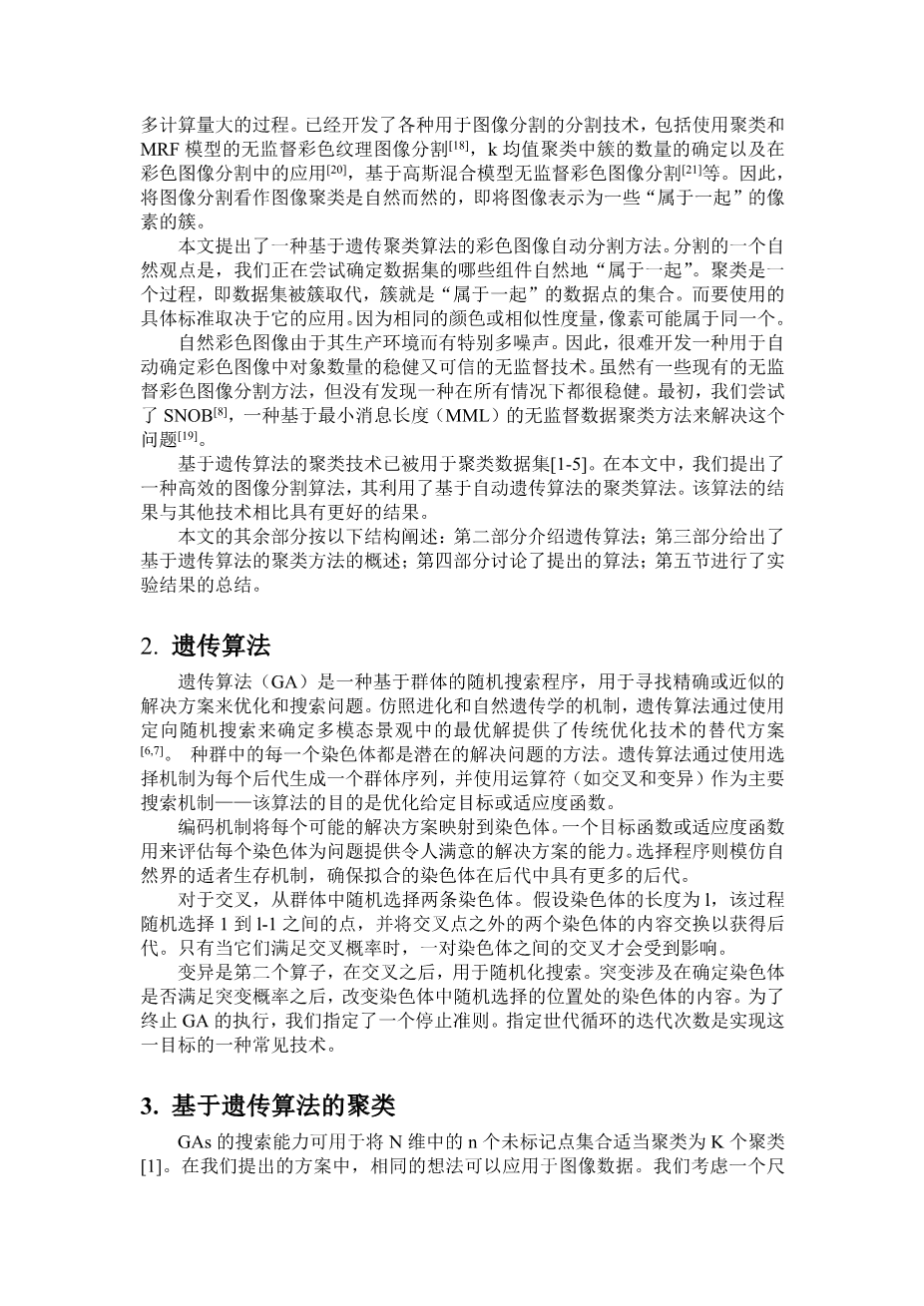Amiya Halder amp; Nilavra Pathak
An Evolutionary Dynamic Clustering Based Colour Image Segmentation
Amiya Halder amiya_halder@indiatimes.com
Assistant Professor
Dept. of Computer Science amp; Engineering
St. Thomasrsquo; College of Engg. amp; Technology
Kolkata, West Bengal, India
Nilavra Pathak nilavrapthk7@gmail.com
Student
Dept. of Computer Science amp; Engineering University
St. Thomasrsquo; College of Engg. amp; Technology
Kolkata, West Bengal, India
Abstract
We have presented a novel Dynamic Colour Image Segmentation (DCIS) System for colour image. In this paper, we have proposed an efficient colour image segmentation algorithm based on evolutionary approach i.e. dynamic GA based clustering (GADCIS). The proposed technique automatically determines the optimum number of clusters for colour images. The optimal number of clusters is obtained by using cluster validity criterion with the help of Gaussian distribution. The advantage of this method is that no a priori knowledge is required to segment the color image. The proposed algorithm is evaluated on well known natural images and its performance is compared to other clustering techniques. Experimental results show the performance of the proposed algorithm producing comparable segmentation results.
Keywords: Segmentation, Clustering, Genetic Algorithm, Clustering Metric, Validity Index.
1. INTRODUCTION
Image segmentation, i.e., the partitioning of an image into relevant regions, is a fundamental problem in image analysis. Accurate segmentation of objects of interest is often required before further analysis can be performed. Despite years of active research, fully automatic segmentation of arbitrary images is still seen as an unsolved problem.
Colour image segmentation emerges as a new area of research. Colour image segmentation can solve many contemporary problems in medical imaging, mining and mineral imaging, bioinformatics, and material sciences. Naturally, color image segmentation demands well defined borders of different objects in an image. So, there is a fundamental demand of accuracy. The segmented regions or components should not be further away from the true object than one or a few pixels. So, there is a need for an improved image segmentation technique that can segment different components precisely. Image data have some particular characteristics that differentiate them from other form of data. Image data may have corrupted values due to the usual limitations or artifacts of imaging devices. Noisy data, data sparsity, and high dimensionality of data create difficulties in image pixel clustering. As a result, image pixel clustering becomes a harder problem than other form of data. Although there are some existing algorithms for unsupervised color image segmentation, none of them has been found to be robust in determining an accurate number of components or segments. Image segmentation is a very important field in image
International Journal of Image Processing (IJIP), Volume (4): Issue (6) 549
Amiya Halder amp; Nilavra Pathak
analysis, object recognition, image coding and medical imaging. Segmentation is very challenging because of the multiplicity of objects in an image and the large variation between them. Image segmentation is the process of division of the image into regions with similar attributes.
The method for the segmentation of digital images can be broadly classified in: (a) edge and line oriented segmentation, (b) region growing methods, (c) clustering, and (d) region splitting methods. Edge and line oriented segmentation work on either individually analyzing each data band or considering the whole vector space. After edge extraction, a processing should be applied to create objects and segments that represent the elements present in the scene. Region growing and splitting method deals commonly with feature extraction and thresholding. In many object based image segmentation applications, the number of cluster is known a priori, but our proposed scheme is automatically determined the optimal number of clustering. The proposed technique should be able to provide good optimal results whereas the K-means algorithm which may get stuck at values which are not optimal [16]. Some of the several unsupervised clustering algorithms developed include K-means [13, 14], fuzzy K-means, ISODATA [11], self-organizing feature map (SOM) [15], particle swarm optimization (PSO) [10], learning vector quantizers (LVQ) [12], Dynamic GA based Clustering [17] etc.
Colour images are more complex than gray scale images as instead of a single intensity value for a pixel, each pixel is usually denoted by three component values such as Red, Green and Blue. Clustering based methods are ideal to use for gray scale images can be easily extended to cope with higher dimensity, although, the increased dimensionality also leads to more computationally expensive process. Various segmentation techniques have been developed for image segmentation include Unsupervised Colour Textured Image Segmentation Using Cluster Ensembles and MRF Model [18], Determination of Number of Clusters in k-means Clustering and application in Colour Image Segmentation [20], Unsupervised Colour Image Segmentation based on Gaussian Mixture Model [21] etc.
This paper presents automatic image segmentation of colour images using GA-based clustering. One natural view of segmentation is that we are attempting to determine which components of a data set naturally “belong together”. Clustering is a process whereby a data set is replaced by clusters, which are collections of data points that “belong together”. Thus, it is natural to think of
全文共21745字,剩余内容已隐藏,支付完成后下载完整资料


英语原文共 9 页,剩余内容已隐藏,支付完成后下载完整资料
资料编号:[16084],资料为PDF文档或Word文档,PDF文档可免费转换为Word
以上是毕业论文外文翻译,课题毕业论文、任务书、文献综述、开题报告、程序设计、图纸设计等资料可联系客服协助查找。


